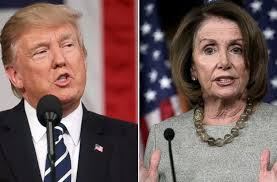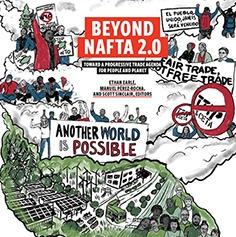Source: Borderlex, 12/10/2018 by Jennifer Freedman
President Donald Trump said he pulled the US out of the Trans-Pacific Partnership because it was a “horrible deal” that stole American jobs while benefiting big corporations. But Washington’s new agreement with Mexico and Canada, the USMCA, has incorporated many elements from TPP (reborn as the Comprehensive and Progressive Agreement for Trans-Pacific Partnership, or TPP-11) and in many ways is more similar to that pact than to the North American Free Trade Agreement it replaced.
After the accord with Canada was struck on 1 October, a White House official told reporters: “We believe this deal has stronger labour provisions than TPP. We believe it has stronger [intellectual property] provisions than TPP. We believe it has stronger environmental provisions than TPP.”
But many disagree.
“Relative to the TPP, the USMCA is a disaster,” Cato Institute’s Dan Ikenson wrote in a commentary on Monday. “Yes, there’s a little more liberalisation in USMCA’s digital trade chapter, better access for US dairy farmers and wine exporters to Canadian markets, a higher threshold for the value of exports not subject to customs duties in Canada and Mexico, and other marginal improvements. But there are considerably more provisions that are protectionist relative to the terms of TPP.”
It was easier for Mexico and Canada to make certain concessions during negotiations with the US because they had already done so as TPP-11 signatories. The main differences are higher standards requiring more car parts to be made in North America rather than in cheaper labour markets, and Canada’s pledge to open about 3.6% of its dairy market to the US – more than the 3.25% it offers TPP-11 partners.
“Two-thirds of this agreement is essentially going back to TPP,” Bruce Heyman, a former US ambassador to Canada, told CNBC last week. “All they did was take so much of the language in TPP and implement it here. We had far more leverage over Canada and Mexico in the TPP negotiations … than we did in the trilateral. I was in the TPP talks with Mexico and Canada; I can tell you, that’s true.”
Textual comparison shows USMCA-TPP similarities
Wolfgang Alschner, a Canadian empirical legal scholar specialised in international economic law and the computational analysis of law, has cobbled together what he called a “quick first attempt of [a] textual comparison” between the USMCA and NAFTA, on one hand, and the USMCA and TPP, on the other.
He found that of the 23 chapters common to all three trade deals, the language of TPP and USMCA was more similar in 20. The three chapters in which the USMCA and NAFTA were more textually similar pertained to trade remedies, publication and administration, and temporary entry for businesspeople.
The language in the government procurement chapters of TPP and the USMCA is about 78% similar, compared with less than 40% in NAFTA-USMCA, Alschner found. In the chapters on state-owned enterprises, the textual similarity in TPP-USMCA in almost 60%, compared with less than 20% for NAFTA-USMCA. In key chapters on intellectual property rights, financial services, sanitary and phytosanitary measures technical barriers to trade and competition policy, the language of TPP-USMCA is overwhelmingly more similar than that of NAFTA-USMCA.
In some ways these findings aren’t a surprise, considering that NAFTA was negotiated more than 25 years ago and its successor, along with TPP-11, are modern trade agreements that cover many new elements.
Where do TPP and the USMCA overlap and diverge?
Some examples of similarities and differences between the two trade agreements follow.
Digital trade/e-commerce: TPP-11 contains an e-commerce chapter and the USMCA equivalent is called “digital trade”. Big chunks of that digital trade chapter are actually copy-pasted from TPP-11. Digital trade didn’t even exist in 1994, when NAFTA entered into force, so Alschner’s chart only shows that almost half of the TPP and the USMCA chapters on digital trade are textually similar.
But the USMCA appears to slam the door on data localisation – or who owns what information, based on where it’s located – by banning any requirement for computing facilities to be in a party’s territory as a condition of doing business.
Although TPP-11 doesn’t address this issue as such, it does contain commitments about the “location of computing facilities”. The core commitment was that the parties to the accord would not compel companies to use or locate a computing facility in their country to be able to conduct business. Other provisions created some latitude for imposing regulatory requirements relating to security and confidentiality of computing facilities.
“TPP-11 recognises that legitimate public policy objectives might lead a country to require the physical presence of computing facilities in carefully constrained circumstances,” Teresa Scassa, a law professor at the University of Ottawa and Canada Research Chair in Information Law, wrote in an op-ed last week.
Workers’ rights: NAFTA offered little when it came to labour rights and the USMCA includes rules designed to better protect workers. More than half of the text in the USMCA and TPP labour chapters are similar, according to Alschner’s chart, but the former gives more rights to workers.
When the US was part of the TPP negotiations, Washington said the pact included “the strongest labour provisions of any trade agreement in history”. After the US withdrew, negotiators were accused of watering down TPP’s labour chapter and critics such as Canadian union leader Lana Payne say workers’ rights in TPP-11 are weaker and, in practice, not legally enforceable in the same way as other chapters in the accord.
The trick with the USMCA will also be enforcement.
“In the area of workers’ rights, the draft text we have seen includes significant improvements over the existing NAFTA and is stronger than the rejected Trans-Pacific Partnership (TPP). It goes farther than any prior trade agreement,” United Steelworkers International President Leo W. Gerard said in a statement.
But “the impact of the deal must be measured not only by what is in the final agreement, but also by what Mexico adopts legislatively to implement its commitments”, he added. “Strong text in an agreement backed up by legislative changes in Mexico will only matter if they are fully and faithfully enforced.”
Drug manufacturers: The USMCA is a win for pharmaceutical companies. Producers of biologic drugs will have a decade of exclusive rights to the data submitted to health regulators to certify them as safe, effectively barring generic alternatives from the market. Under TPP, that timeline was five to eight years, matching current US law.
In this case, shareholders in pharmaceutical companies will benefit, but Americans, Canadians and Mexicans are likely to face higher prices at the drug counter.
The assessment of Fordham law professor Matthew Gold, a former deputy assistant to the USTR, is that Trump could have spared the US – as well as Canada and Mexico – the headache of renegotiating NAFTA by remaining in TPP. Especially considering that the new trilateral accord is unlikely to have much of an economic impact.
“He got a large number of small updates, most of which were in the TPP agreement which Trump pulled out of,” Gold told CNBC. “He got us back to a small increased access to the Canadian dairy market, almost all of which was in the TPP he pulled out of.”
Cato’s Ikenson acknowledges that USMCA “is certainly better in some regards” than NAFTA. “But even if its provisions could be demonstrated to be, on net, more liberalizing than the TPP’s (to be sure, they cannot!), there is still the major shortcoming that TPP offered liberalisation with nearly 300 million more people in nine more countries accounting for a combined GDP of $7.5 trillion. Canada and Mexico account for an aggregate $2.8 trillion. So, yeah.”
__________________________
Juergen Knirsch
Trade Policy Adviser

